For more than eighteen centuries, paper was made with rags — such as old clothes, sails and ropes — the same way it had first been fashioned in China. But, by the nineteenth century, the process of book-publishing was being mechanized, the demand for books was growing exponentially and there simply weren’t enough rags anymore.
So, paper-makers tried straw, corn husks and even seaweed. The breakthrough occurred when Friedrich Gottlob Keller of Saxony came up with wood pulp.
The history of paper, with that interesting little detour to seaweed, is covered in quick, expert fashion in a two-page spread fairly early in The Book by Design: The Remarkable Story of the World’s Greatest Invention, a book rich with treasures of the British Library and published in the U.S. by the University of Chicago Press.
The book is edited by P.J.M. Marks and Stephen Parkin, two high-level curators at the Library, who note in an introduction:
The Book by Design celebrates the ‘book’ in all its forms, whether manuscript, printed or digital; scroll or codex; on parchment, paper, palm leaves or cardboard; shaped like a concertina or with moving parts; or of huge or miniature proportions.
How huge? Well, The Birds of America, from Original Drawings by John James Audubon (1827-1838) is 3.3 feet by 2.2 feet.
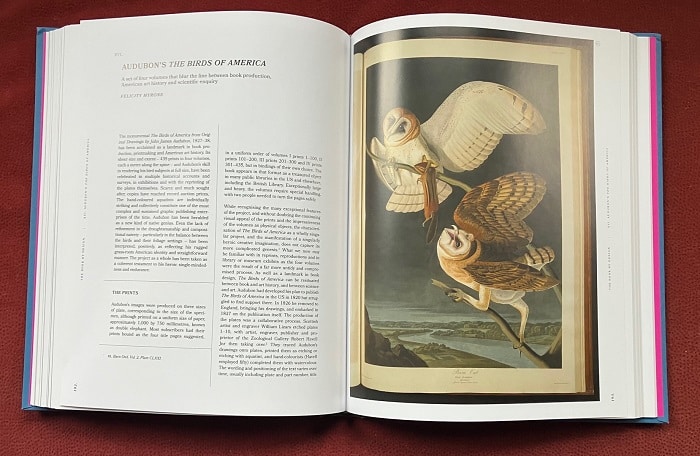
How miniature? The New Testament, published by Christopher Barker in 1593, is three inches by two inches. But that’s about four times larger than the English Bijou Almanac [for 1836], which features portraits of famous writers, musicians, painters and stage performers as well as poems in their praise, in a volume that is 0.7 inches by 0.5 inches.
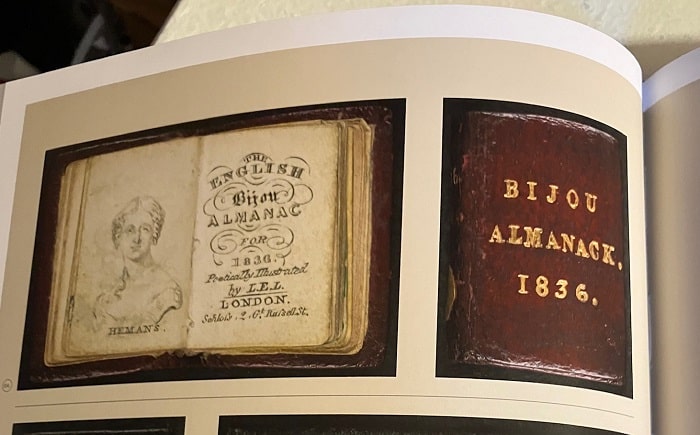
Originally part of the British Museum, the British Library has been collecting books of all sorts for two and a half centuries. Fifty years ago, it was established as a separate institution and is one of the largest libraries in the world, containing as many as 200 million books and other items, or about as many as the Library of Congress.
The holdings and expertise of the British Library
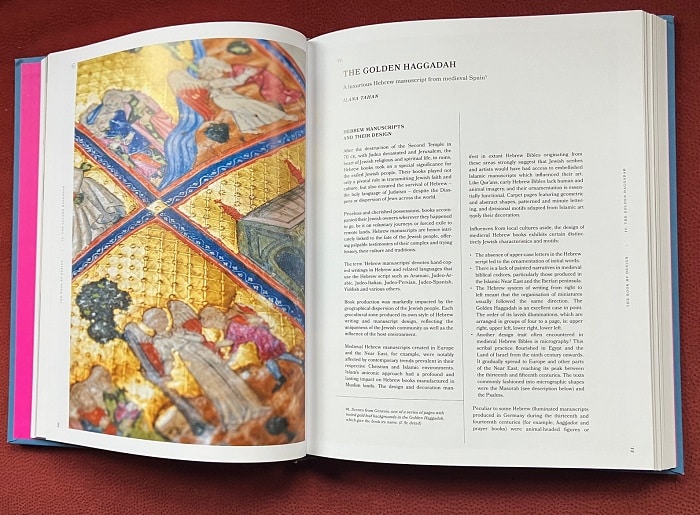
The depth of the British Library’s holdings can be seen in The Book by Design with chapters ranging from the Mainz Psalter (1457) to Sadok Sudei and other books made of wallpaper by the avant-garde Futurists in Russia in the 1910s; from Vessantara Jataka (The Buddha’s Last Birth Tale) incised on palm leaves in the nineteenth century to the Golden Haggahdah, “the most lavishly embellished and best preserved” Hebraic treasure of the fourteenth century Spain; from Sea Air by Susan Allix, a 2018 work of art created in the format of a book, to the First Folio, Mr. William Shakespeares [sic] Comedies, Histories, & Tragedies, published in 1623, collecting 36 plays, 18 of which had never before been in print.
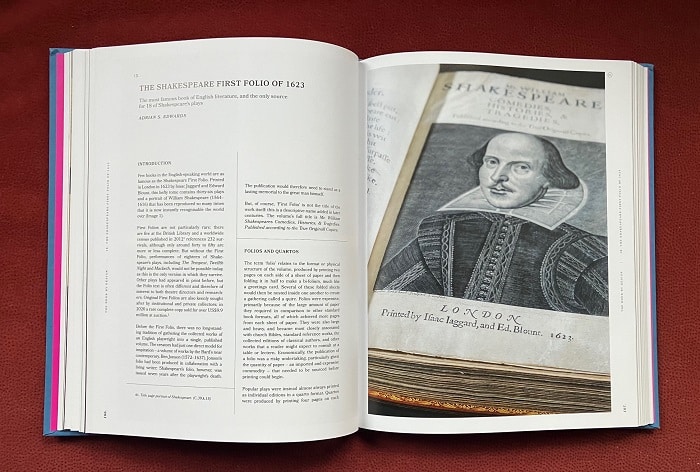
And the depth of the Library’s expertise can be seen in the list of 33 writers who contributed 21 chapters and 17 sidebars, such as the one on the history of paper. Nearly all of the writers are Library employees with titles that suggest the breadth of the institution’s collections — for instance, Adrian S. Edwards, Head of the Printed Heritage Collections; Ilana Tahan, Lead Curator for Hebrew and Christian Orient Collections; Jeremy Jenkins, Curator of Emerging Formats, Contemporary British & Irish Published Collections; and Karen Limper-Herz, Lead Curator of Incunabula and Sixteenth Century Printed Books.
Through examples from the Library’s collections, The Book by Design tells a multi-faceted story of how books around the world have been formatted, produced, packaged and presented over the last fourteen centuries.
An embodiment of beautiful book design
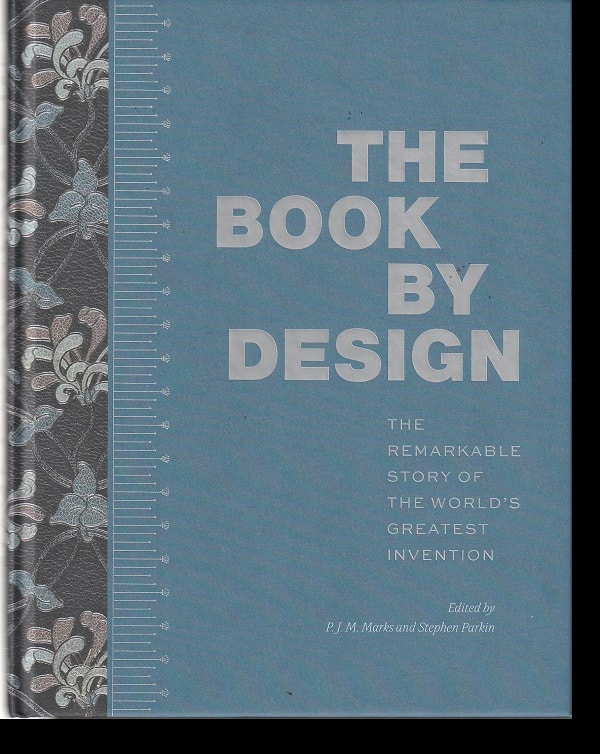
And, as a physical object, it is itself an embodiment of clear, beautiful and apt book design.
Books like this are often described as lavishly illustrated, and The Book by Design certainly is. But its hundreds of full-color images — scores of which are presented over a full page or a two-page spread — have been placed on the work’s 261 pages with the skill and eloquence that an artist uses to set rubies onto the exterior of a gold jewelry box or chalice.
There is a tangible rhythm and balance to The Book by Design, an interaction among the images, the text presented in double columns and the calm, serene white space that forms the background and frame to everything, as if they were a chamber music trio playing a string quartet by Haydn.
The images are bold and big, but they don’t dominate. The text is presented in a sober, engaging manner that allows the words to stand up for themselves. The white space is subtly used to give the book and its pages a humane harmony. This is an illustrated book that you can — and should — read. It is much more than just pretty pictures.
Striking images
Even so, its bold and big images are striking and, often, stop you in your tracks. Books, of course, are static things, but Photographer Jonathan Vines has found surprisingly inventive and imaginative ways of snapping an image that seems to enable to reader to almost touch the book.
Consider, for instance, Excerpts from the Tale of Genji, a seventeenth-century Japanese album of calligraphy and painting that is an example of a binding structure known as orijo, or folding album, which results in a book that looks like a concertina. Vines’s two-page photograph of this book, standing on a tabletop with its pages fanning open from the binding, handsomely displays this concertina, or accordion, style.
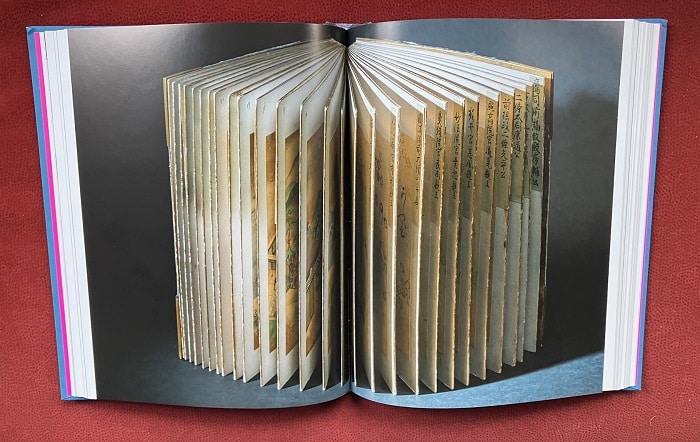
In another example, Vines has photographed an elegant Qur’an from 1820s Aceh, Indonesia, to show the open book with its distinctive decorative framing around the sacred text. But even more striking, on another page, is an extreme close-up of the book’s cloth binding with its appliqued paper pattern inscribed with the shahada (the Islamic creed, translated as “There is no god but God, and Muhammad is the Messenger of God”).
For people who love books
For the story it tells and the way it presents that story, The Book by Design is a book for people who love books.
Perhaps the greatest compliment I could give it is that it is so well-done, so well-designed, that it could be the subject of one of its own chapters.
.
Patrick T. Reardon
3.22.24
This review was first published by Third Coast Review on 2.17.24.
Written by : Patrick T. Reardon
For more than three decades Patrick T. Reardon was an urban affairs writer, a feature writer, a columnist, and an editor for the Chicago Tribune. In 2000 he was one of a team of 50 staff members who won a Pulitzer Prize for explanatory reporting. Now a freelance writer and poet, he has contributed chapters to several books and is the author of Faith Stripped to Its Essence. His website is https://patricktreardon.com/.
